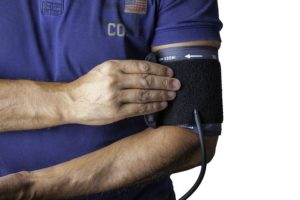What causes high blood pressure?

For most people, the cause is unknown. In this article we will describe what causes of high blood pressure – and how to investigate a patient with high blood pressure.
Primary (essential) high blood pressure (hypertension)
Accounts for about 90% of cases. And there is no identifiable cause. It is likely multifactorial, involving genetics, lifestyle, and environmental factors:
- Family History: A family history of hypertension can increase an individual’s risk
- Age: Hypertension risk increases with age
- Ethnicity: Black and Asian people are more prone to hypertension. Black people can get severe hypertension.
- Lifestyle Factors: Excess weight, physical inactivity, and a diet high in salt and sugar can contribute to hypertension.
Secondary high blood pressure (hypertension)
This means the high blood pressure is caused by an underlying condition (about 10% of cases).
There are 5 main groups of causes of secondary hypertension.
1. Renal disease
- Chronic kidney disease (CKD; all causes), including:
- Renal artery stenosis (RAS; also known as renovascular disease, RVD). Can be caused by fibromuscular dysplasia (FMD), especially in younger people (females more commonly). This is important to exclude
- Other causes of CKD: can also cause high BP: reflux nephropathy/chronic pyelonephritis (CP), diabetic nephropathy (DN), glomerulonephritis (GN), polycystic kidney disease (PKD), obstructive nephropathy (ON).

Renal angiogram: showing fibromuscular dysplasia, with beading in renal artery and branches
- Renal cell carcinoma.
2. Cardiac disease
- Coarctation of the aorta: systolic murmur
- Aortic regurgitation (AR): diastolic murmur, and wide pulse pressure.
3. Endocrine disease
- Diabetes
- Cushing’s Syndrome
- Conn’s Syndrome (hyperaldosteronism)
- Thyroid disease (hyper- or hypo-thyroidism)
- Acromegaly
- Phaeochromocytoma. This is very rare.
4. Medication
- Corticosteroids
- Oral contraceptives (and other oestrogen containing)
- Sympathomimetics
- Other drugs: ciclosporin/tacrolimus, cocaine, and non-steroidal anti-inflammatory drugs (NSAIDs),
5. Other
- Obstructive sleep apnoea (OSA)
- Pregnancy (pre-eclampsia and eclampsia).
Note. BP is normally low in pregnancy. So 130/80 can be a disease.
Investigation of high blood pressure
Initial evaluation (most patients only need these)
-
Urine dipstick: To detect proteinuria or haematuria, suggesting renal disease (if positive, do urinary ACR)
-
Blood urea and electrolytes (U&Es): To assess renal function. Hypokalaemia suggests Conn’s and Cushing’s Syndrome
-
Blood creatinine: To estimate glomerular filtration rate (eGFR).
Specific tests for secondary causes (a minority of patients need these)
- Cardiac causes
-
ECG: To assess for left ventricular hypertrophy or other cardiac effects of hypertension
-
Chest x-ray: To evaluate for signs of cardiac failure or other thoracic abnormalities
-
Echocardiogam (ECHO): To look for aortic regurgitation (AR) or coarctation.
-
-
Conn’s Syndrome (primary aldosteronism)
-
Serum aldosterone-to-renin ratio (ARR)
- 24-hour urinary aldosterone excretion.
-
-
Cushing’s Syndrome
-
24-hour urinary free cortisol
-
Late night salivary cortisol on two occasions
-
1 mg overnight dexamethasone suppression test.
-
-
Phaeochromocytoma
-
Plasma free metanephrines (or urinary fractionated metanephrines)
-
Clonidine suppression test (if metanephrines are borderline).
-
- Renal artery stenosis
- CT or MR angiography.
-
Renal disease (primarily CKD)
-
Renal ultrasound
-
U&Es, creatinine/GFR
-
Urine albumin-to-creatinine ratio (ACR).
-
-
Thyroid disease
-
Thyroid function tests (TSH, free T4, and free T3).
-
When to suspect a secondary cause
-
Resistant hypertension: Blood pressure remains uncontrolled despite optimal doses of three antihypertensive agents
-
Atypical presentation: Hypertension in young patients, abrupt onset, or rapid acceleration
- Accelerated hypertension (hypertensive emergency): >180/120; rapid rise; most are unwell
-
Clinical features: Suggestive signs or symptoms, such as hypokalaemia (primary hyperaldosteronism), tachycardia or sweating (pheochromocytoma), or moon facies and striae (Cushing’s syndrome).
Note. Accelerated hypertension can cause breathlessness, blurred or double vision and nose bleeds as well as a persistent headache. This is rare.
Summary
We have described what causes of high blood pressure – and how to investigate a patient with high blood pressure. We hope it has been helpful.
Other resources
Investigation secondary hypertension in adults
10 most common blood pressure tablets
What causes low blood pressure?

